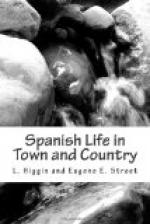A gala procession in Madrid is something to be remembered, if it be only for the wealth of magnificent embroideries and fabrics displayed. The royal carriages are drawn by eight horses, having immense plumes of ostrich feathers, of the royal colours, yellow and red, on their heads, and gorgeous hangings of velvet, with massive gold embroideries reaching almost to the ground; the whole of the harness and trappings glitter with gold and silk. The grooms, leading each horse, are equally magnificently attired, their dresses being also one mass of needlework of gold on velvet. Equerries, outriders, and military guards precede and surround the royal carriages, and the cavalcade is lengthened by having a coche de respecto, caparisoned with equal splendour, following each one in which a royal person is being conveyed. Behind come the carriages of the Grandes, according to rank, all drawn by at least six horses, with trappings little, if at all, inferior to those of the Court, and each with its enormous plume of gaily-coloured ostrich feathers, showing the livery of its owner. In addition to all this grandeur, the balconies of the great houses lining the route of the processions display priceless heirlooms of embroideries, hanging before each window from basement to roof. If these ancient decorations could speak, what a strange story they might tell of the processions they have seen pass! In honour of the victories over the Moors; of the heroes of the New World; of the miserable murders of the Autos-da-fe; of the entry of the Rey absoluto, to inaugurate the “Terror,” on to the contemptible “galas” of Isabel II., supposed to keep the people quiet; and, almost the last, the entry of Alfonso XII., after he had put an end to the Carlist war! On the day of rejoicing for “La Gloriosa” there was no such display, although all Madrid was en fete. It was the triumph of the people, and their heirlooms do not take the form of priceless embroideries.
In former days the receptions at the Palace were known as besamanos (to kiss hand). On Holy Thursday the Royal Family and all the Court visit seven churches on foot—at least, that is the correct number, though sometimes not strictly adhered to. As no vehicular traffic is allowed on that day or on Good Friday, the streets where the royal procession pass are swept and laid with fresh sand. The ladies are in gala costume, and drag their trains behind them, all wearing the national mantilla. All Madrid also visits its seven or less number of churches, passing without obeisance before the high altars, on which there is no Host,—as the people will tell you su Majestad is dead,—and after the funcion is over there is a general parade in the Puerta del Sol and the Carrera de San Geronimo, to show off the smart costumes of the ladies, while the officers sit in chairs outside the Government offices and smoke, admiring the prospect.




